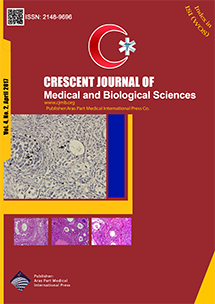
| Original Article | |
| Pharmacological and Non-pharmacological Therapeutic Strategies for Improvement of State-Trait Anxiety: A Randomized Controlled Trial Among Iranian Infertile Women With Sexual Dysfunctions | |
| Hajar Pasha1, Zahra Basirat2, Mahbobeh Faramarzi3, Farzan Kheirkhah4 | |
| 1PhD Student, Infertility and Reproductive Health Research Center, Health Research Institute, Babol University of Medical Sciences, Babol, Iran 2Full Professor of Gynecology, Infertility and Reproductive Health Research Center, Health Research Institute, Babol University of Medical Science, Babol, Iran 3Associate Professor of Psychology, Social Determinants of Health Research Center, Babol University of Medical Sciences, Babol, Iran 4Associate Professor in Psychiatry, Departments of Psychiatry, Faculty of Medicine, Babol University of Medical Sciences, Babol, Iran |
|
|
CJMB 2017; 4: 047-053 Viewed : 22817 times Downloaded : 8507 times. Keywords : Anxiety, STAI, Psychotherapy, Bupropion, Infertility, Sexual dysfunctions |
|
| Full Text(PDF) | Related Articles | |
| Abstract | |
Objective: To compare the effects of pharmacological and non-pharmacological therapeutic strategies for improvement of state-trait anxiety among Iranian infertile women with sexual dysfunctions (SDs). Material and Methods: In a randomized controlled clinical trial, 105 women with infertility suffering from SDs were randomly assigned to participate in a 2-hour group weekly session of psychosexual therapy (PST) (n = 35), took a tablet of bupropion ER 150 mg/d (BUP ER) (n = 35), or control (n = 35) for 8 weeks during 2014–2015. The Female Sexual Function Index (FSFI) and Spielberger State-Trait Anxiety Inventory (STAI) were completed before and after of the study. Results: State and trait anxiety levels had mean values of 47.80 ± 10.93 and 48.78 ± 11.34, respectively. Mean values of state and trait anxiety levels observed at baseline significantly decreased toward the end of the study in each of the treatment groups (PST, P < 0.0001 and P < 0.0001; BUP, P < 0.005 and P < 0.001, respectively), and the decrease was more significant in the PST group than in the BUP ER group (P < 0.001 and P < 0.007, respectively) and the control group (P < 0.0001) and P < 0.0001, respectively). Significantly high improvement in state and trait anxiety levels was observed in the PST group than the BUP and control groups. However, the decrease in the BUP group was not significant than the control group (P < 0.076 and P < 0.186, respecttively). Conclusion: PST compared to bupropion ER treatment was found to be a more favorable strategy for improvement of state and trait anxiety symptoms. |
Cite By, Google Scholar
Google Scholar
PubMed
Online Submission System
 CJMB ENDNOTE ® Style
CJMB ENDNOTE ® Style
 Tutorials
Tutorials
 Publication Charge
Medical and Biological Research Center
About Journal
Publication Charge
Medical and Biological Research Center
About Journal
Aras Part Medical International Press Editor-in-Chief
Arash Khaki
Deputy Editor
Zafer Akan


















